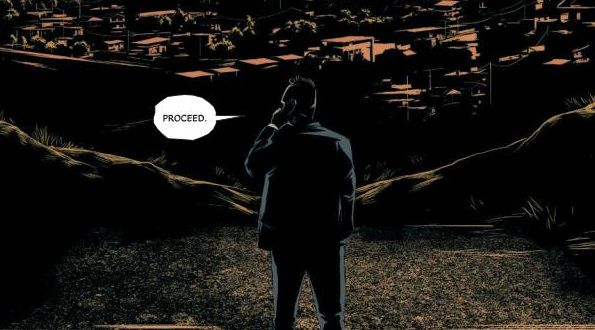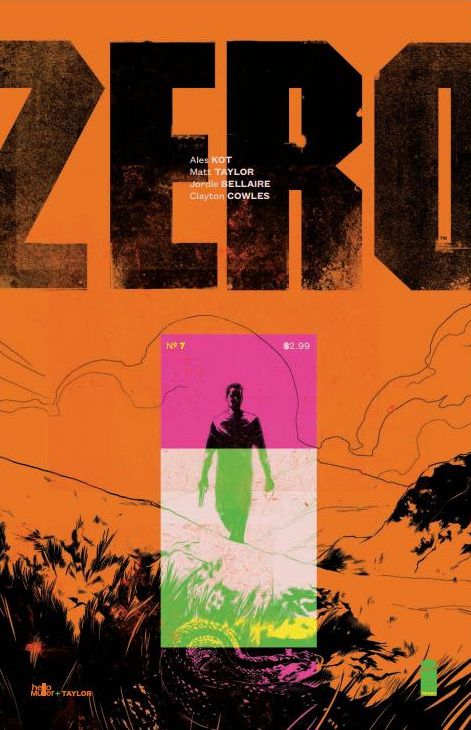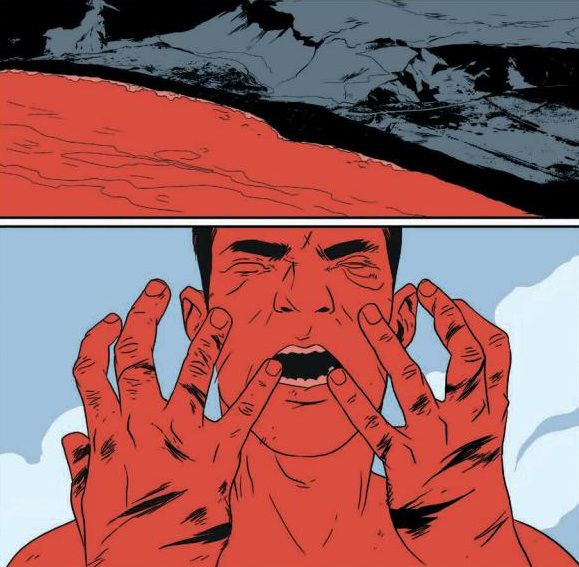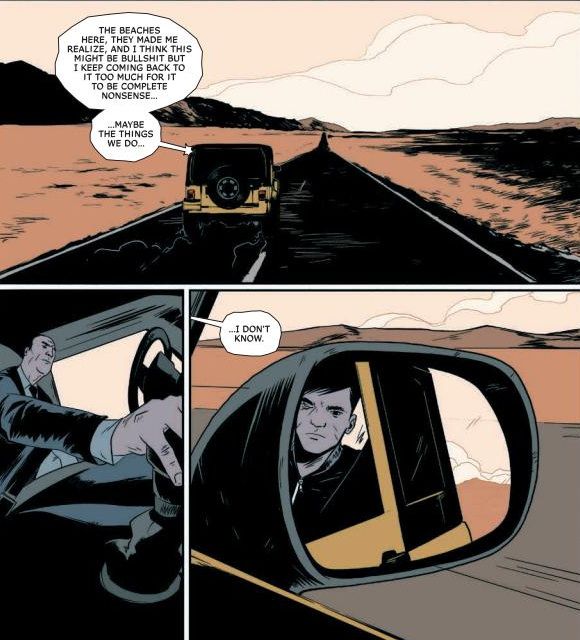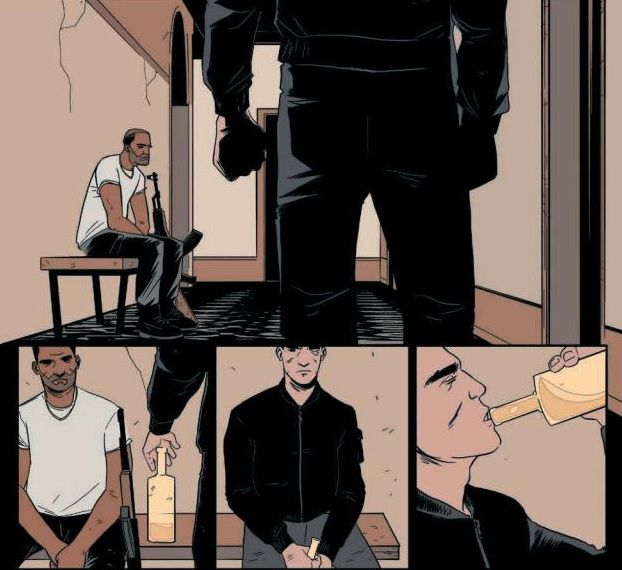"Emptiness is loneliness, and loneliness is cleanliness, and cleanliness is godliness, and god is empty just like me"
The use of dialogue in a work of fiction is a minefield, from writers over-explaining things through their characters' dialogue to writers trying too hard to be clever and leaving crucial things unsaid. It's a fine line between philosophical and obtuse, and many writers don't know the difference, with only the audience to tell them which is which. In comics, dialogue is often overused, as writers don't trust their artists to fill the gaps in the verbiage with recognizable expressions or hints in body language.
In comics, the writer often doesn't even know if the artist is capable of that, and might not know until he or she sees the final product. It's why some writers always work with the same artists, because they've constructed a relationship with an artist that holds up and which precludes the anxiety of wondering whether an artist can interpret a script in just the right way.
In his brief comics career, Ales Kot has proven that he knows a thing or two about writing, and his work on Zero, including issue #7, which he was nice enough to send to me, shows that quite well. Zero is punctuated by extreme violence, but in between, Kot trusts his artists - including Matt Taylor, another very new comics creator - to interpret his scripts in a way that allows Kot to use fewer words, and in a visual medium, the fewer words a writer can use often means the bigger the impact the ones that are there have. Several pages in Zero #7 are silent, as Kot gives Taylor images to draw but doesn't feel the need to back those images up with explanation. Edward Zero, our damaged spy, stands on a beach in a dream and screams as he looks at his bloody hands. Taylor draws anguish well, and Jordie Bellaire colors both Zero and the water in the ocean a bright tomato red before our protagonist wakes up and goes to work. In the jeep with his handler, Zizek, he has a conversation that Kot makes just opaque enough to be deep, but once again doesn't push too far, allowing Taylor to etch trauma into Zero's face that pays off later in the issue.
Then Taylor gets to draw a nine-panel grid in which Zizek discourses about love, and once again, Kot writes just enough to give us the gist while Taylor shows the roil of emotions through which he's moving. Kot wisely uses no words in the final three pages of the issue, as he reaches a traumatic event that changes what we know about the series. The final words in the issue, in fact, reveal how much pain Zero has been living with, and what he's willing to do about it. It's a powerful moment, because Zizek thinks he's the only one with a human heart, even though it's clear over the course of the series that Zero himself feels things too powerfully, as well. Earlier in the issue, he witnesses something horrifying, and even though Kot doesn't show us what he sees, we can infer it from context, and it's a brutal moment. Kot and Taylor do a marvelous job showing Zero trying to hold everything in, because it's clear he needs to be on point for the job. Taylor draws the man who is trying to justify what's going on beautifully - he can't meet Zero's eyes, and with simple lines showing that his own eyes are closed, Taylor implies both the moral gymnastics he does to make it through the day and the pain it causes him. Kot's one misstep in the issue is making the title - "Kali Yuga" - part of a speech by the main bad guy, as it feels a bit too on-the-nose. This is why titles exist, as naming the issue "Kali Yuga" but not mentioning it at all would make the few moments of horror resonate even more - Zizek's speech at the end, Zero's dream, and the man's attempts to justify abominations would all feed into the central idea of the issue, and the bad guy wouldn't have to spell it out quite as much. Still, the fact that the bad guy is so articulate is a nice conceit.
Bellaire has been coloring this series in a very interesting way - blue tends to be the dominant hue, even in issues where she doesn't use it that much. The cooler tone helps create a mellow mood, which works against the tension that Kot and his artists are building up in every issue.
It's an odd choice, but an effective one, as it allows her to drop flashes of violent red into the narrative at crucial times as well as use a yellow/blue complement without making it too obvious that she's doing it. In the indoor scenes, she uses more muted browns, but it's significant that the bad guy wears a blue shirt that's the same hue as the light in the room where the horror is occurring. Bellaire links the man to the horror quite nicely. One of the reasons why Bellaire has become one of the best colorists in the business shows up early in the book, when she gradually lightens the early sky from the purples of dawn to the beige of day over the course of a few pages. It's something that not many people would think about, showing the passage of time that way, but Bellaire does, and it's a neat trick. In some of her books, Bellaire adds layers to the artwork to add dimensions, but she doesn't do that in Zero, which is an interesting choice. The flatness of the colors don't mean it's a boring book; the palette she uses is interesting on its own. But it makes the book starker than it might otherwise be, bringing the emotions the artists draw to the raw surface, which is where they should be. Zero is a fairly brutal book, and Bellaire's colors are a part of that brutality.
Kot has somehow managed to create a comic where almost every issue is a game-changer, even though we already know some of the events that are going to happen because he's telling the story out of chronological order. That's an impressive achievement, and it's partly why Zero is such a cool comic. As long as Kot continues to trust his artists and as long as they repay that trust, we should continue to get issues in which Kot doesn't have to write too many words because the artists are able to visually convey what he's trying to say. That's a pretty cool synergy to have, especially when you're using a new artist for each issue.
Zero #7 is written by Ales Kot, drawn by Matt Taylor, colored by Jordie Bellaire, and lettered by Clayton Cowles. It's published by Image, costs $2.99, and will be on the shelves on Wednesday, 23 April.
Rating: ★ ★ ★ ★ ★ ★ ★ ★ ☆ ☆

